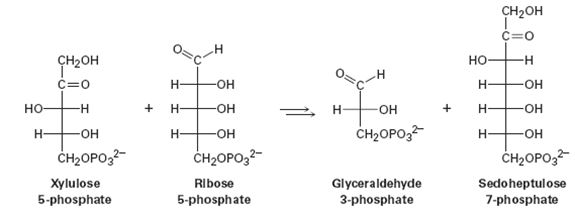
Concept explainers
One of the steps in the pentose phosphate pathway for glucose catabolism is the reaction of xylulose 5-phosphate with ribose 5-phosphate in the presence of a transketolase to give glyceraldehyde 3-phosphate and sedoheptulose 7-phosphate.

(a) The first part of the reaction is nucleophilic addition of thiamin diphosphate (TPP) ylide to xylulose 5-phosphate, followed by a retro-aldol cleavage to give glyceraldehyde 3-phosphate and a TPPcontaining enamine. Show the structure of the enamine and the mechanism by which it is formed.
(b) The second part of the reaction is addition of the enamine to ribose 5-phosphate followed by loss of TPP ylide to give sedoheptulose 7-phosphate. Show the mechanism.
Trending nowThis is a popular solution!

Chapter 29 Solutions
ORGANIC CHEMISTRY-EBOOK>I<
Additional Science Textbook Solutions
College Physics: A Strategic Approach (3rd Edition)
Physical Science
Organic Chemistry
Applications and Investigations in Earth Science (9th Edition)
- The table shows the tensile stress-strain values obtained for various hypothetical metals. Based on this, indicate which material will be the most ductile and which the most brittle. Material Yield strength Tensile strength Breaking strain Breaking strength Elastic modulus (MPa) (MPa) (MPa) (GPa) A 310 340 0.23 265 210 B 100 120 0.40 105 150 с 415 550 0.15 500 310 D 700 850 0.14 720 210 E - Non-effluence fracture 650 350arrow_forwardPlease correct answer and don't used hand raitingarrow_forwardDon't used hand raitingarrow_forward
- Consider the following Figure 2 and two atoms that are initially an infinite distance apart, x =00, at which point the potential energy of the system is U = 0. If they are brought together to x = x, the potential energy is related to the total force P by dU dx = P Given this, qualitatively sketch the variation of U with x. What happens at x=x? What is the significance of x = x, in terms of the potential energy? 0 P, Force 19 Attraction Total Repulsion x, Distance Figure 2. Variation with distance of the attractive, repulsive, and total forces between atoms. The slope dP/dx at the equilibrium spacing xe is proportional to the elastic modulus E; the stress σb, corresponding to the peak in total force, is the theoretical cohesive strength.arrow_forwardDenote the dipole for the indicated bonds in the following molecules. H3C ✓ CH3 B F-CCl 3 Br-Cl H3C Si(CH3)3 wwwwwww OH НО. HO HO OH vitamin C CH3arrow_forwardFor the SN2 reaction, draw the major organic product and select the correct (R) or (S) designation around the stereocenter carbon in the organic substrate and organic product. Include wedge-and-dash bonds and draw hydrogen on a stereocenter. Η 1 D EN Select Draw Templates More C H D N Erasearrow_forward
